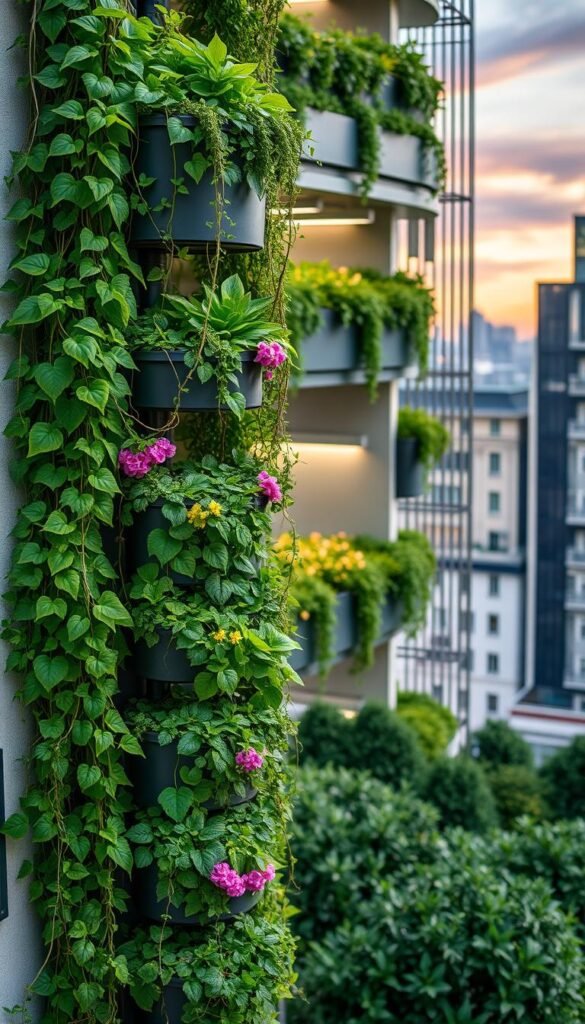Ever feel like your outdoor area is too cramped for plants? You’re not alone. Over half of city residents now use vertical setups to bring greenery into their homes, according to recent trends. This approach turns blank walls, fences, and even balcony rails into lush, productive spaces without eating into your floor area.
Imagine harvesting herbs from a repurposed ladder or growing strawberries on a sunny windowsill. Tiered planters and hanging systems let you multiply your growing capacity while adding visual interest to patios and balconies. Studies show these setups use 90% less water than traditional gardens—perfect for eco-conscious growers.
Urban living doesn’t mean sacrificing fresh food or nature’s benefits. Vertical layouts can lower stress levels by 30% while filtering pollutants from your surroundings. For inspiration, explore these creative solutions tailored for tight spaces that turn bland walls into thriving ecosystems.
Whether you’re working with a fire escape or a tiny yard, stacking plants upward unlocks new possibilities. Hydroponic systems can boost vegetable yields by 30%, and lightweight materials keep structures manageable. Your space isn’t limited—it’s just waiting to be reimagined.
Understanding Vertical Gardening Benefits and Opportunities
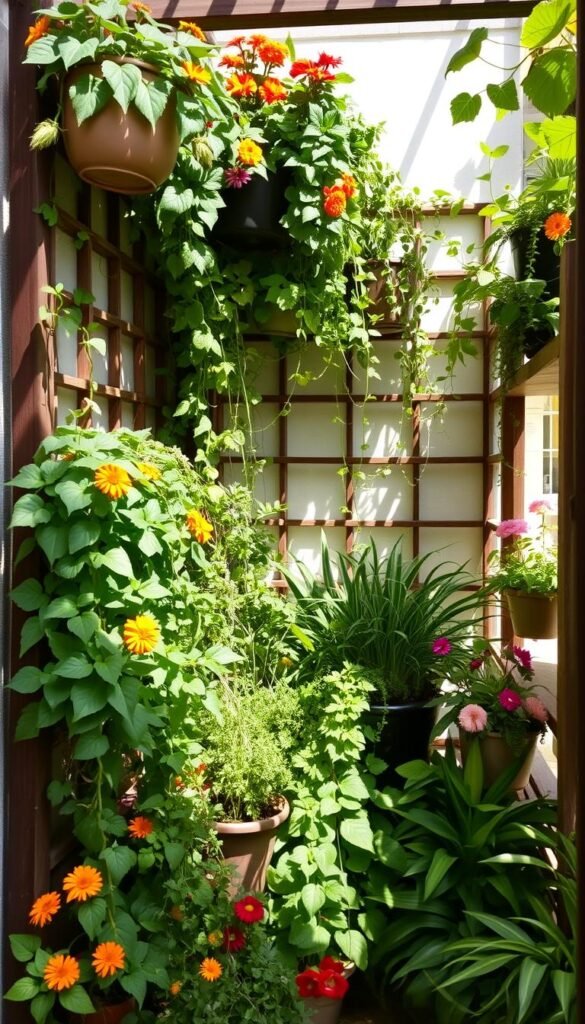
Want more plants but lack the square footage? Modern growing methods let you think beyond the ground. By building upward, you unlock hidden potential in overlooked areas like walls, railings, and narrow corners.
Maximizing Your Outdoor Space
Your balcony or patio can host 5x more plants with smart vertical systems. Stacked planters or wall-mounted pockets turn blank surfaces into herb havens. Research shows these setups yield 10x more food per square foot than traditional beds—ideal for tomatoes, greens, or strawberries.
Even tricky spots shine. Sloped areas or poor soil become productive when you use hanging baskets or tiered shelves. The height advantage creates microclimates: place sun-lovers up top and shade-tolerant plants below.
Improving Urban Aesthetics
Concrete walls transform into living art with climbing vines or flowering annuals. These green barriers filter pollutants while softening harsh city views. One study found they reduce nearby noise by up to 40%.
Mix function and beauty by pairing edible plants with colorful blooms. For example, pair purple basil with trailing petunias in a wall planter. Discover more creative gardening ideas to blend style and productivity effortlessly.
Vertical Garden Design: Innovative Ways to Grow Upward
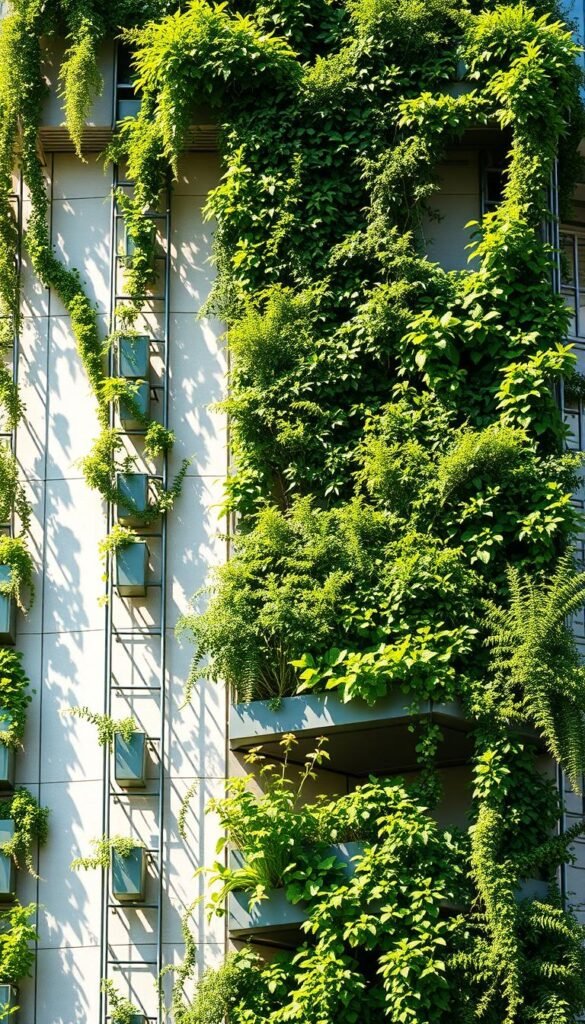
Ever stared at an empty wall and imagined it bursting with life? Creative frameworks turn unused spaces into vibrant plant displays. Let’s explore how different setups merge practicality with visual charm.
Structures That Elevate Your Space
Obelisks and pergolas aren’t just decorative—they’re plant powerhouses. Train jasmine or passionfruit vines up these frameworks for fragrant, edible screens. Rustic wigwams made from bamboo poles give beans and peas perfect climbing routes.
Don’t overlook tight spots. Cram sedums into brick gaps for fire-resistant greenery that survives droughts. These succulent mosaics need watering just once a month but deliver year-round color.
| Structure Type | Best Plants | Space Saved | Care Level |
|---|---|---|---|
| Tower Systems | Lettuce, herbs | 90% | Low |
| Wall Crevices | Sedums, hens-and-chicks | 100% | Minimal |
| Hydroponic Towers | Basil, strawberries | 95% | Moderate |
Hydroponic systems change the game entirely. Nutrient-rich water flows through stacked pods, letting you grow 30 plants where one pot would fit. These soil-free setups yield harvests 3x faster than dirt-based methods.
Your style preferences matter too. Geometric metal planters suit modern patios, while upcycled pallets create eco-friendly herb walls. Mix materials and plant types to match your home’s personality perfectly.
Creating Living Walls and Green Facades
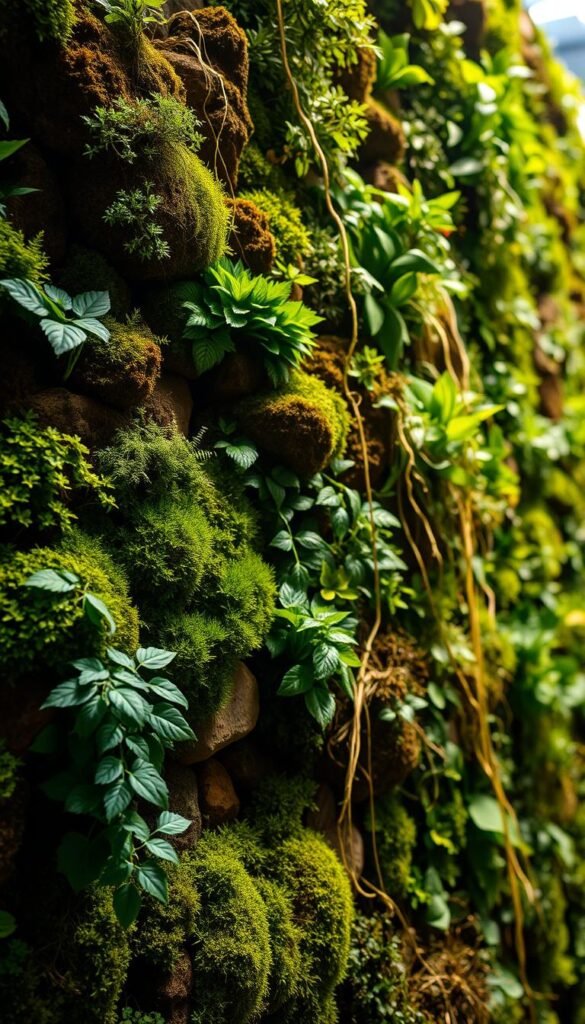
What if your blank walls could breathe life into your space? Living walls turn unused surfaces into thriving plant displays, packing 30-40 greens per square meter. These lush installations clean air, reduce noise, and transform bland fences into living art—but they need smart planning to thrive.
Selecting the Right Materials
Your material choices make or break a living wall. UV-stabilized plastic resists sun damage for years, while powder-coated metal frames handle heavy loads. Fabric pocket systems work great for lightweight herbs like mint or thyme.
Drainage matters most. Look for self-watering modules with built-in reservoirs or grids that let excess moisture escape. Test materials by spraying water—if it pools, roots might rot.
DIY Repurposing Ideas
Turn household items into plant homes. Old shoe organizers become fabric pockets for succulents. Cut plastic bottles into horizontal planters and mount them in staggered rows.
Wooden pallets lined with landscape fabric create instant herb walls. For stability, secure them with metal brackets. These projects cost 80% less than store-bought kits and add personal flair.
Incorporating Functional Elements in Your Vertical Garden
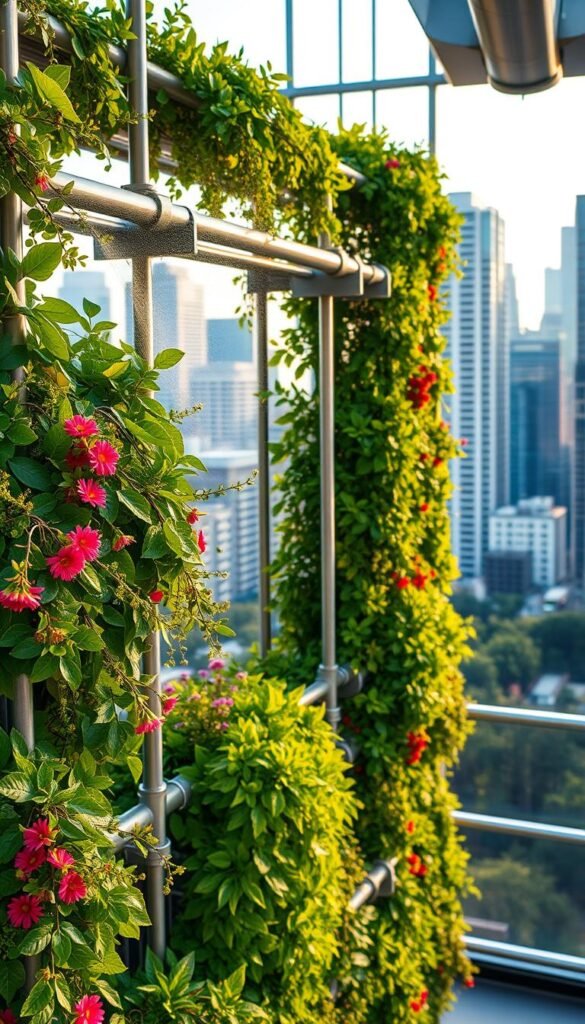
What keeps your elevated plants thriving? Smart water management transforms wall-mounted setups from pretty displays into productive ecosystems. Let’s explore how to build reliability into your green walls.
Integrated Irrigation and Watering Techniques
Drip systems work like silent helpers for your plants. Tiny tubes deliver moisture straight to roots, cutting water use by 70% versus sprinklers. Micro-drippers adjust flow rates automatically—no more guessing if vines got enough hydration.
Self-watering setups take convenience further. Built-in reservoirs feed plants through capillary action for up to two weeks. Pair these with soil sensors, and you’ll receive alerts when levels dip below ideal ranges.
Drainage can’t be an afterthought. Slope your planters slightly and add overflow outlets to prevent soggy roots. Reinforced frames handle heavy wet soil without warping—crucial for long-term vertical garden success.
Track performance with clear indicators. Transparent reservoir walls show water levels at a glance, while moisture meters guide refill timing. These tweaks keep greens lush with minimal effort.
Exploring Smart Technology for Vertical Gardening
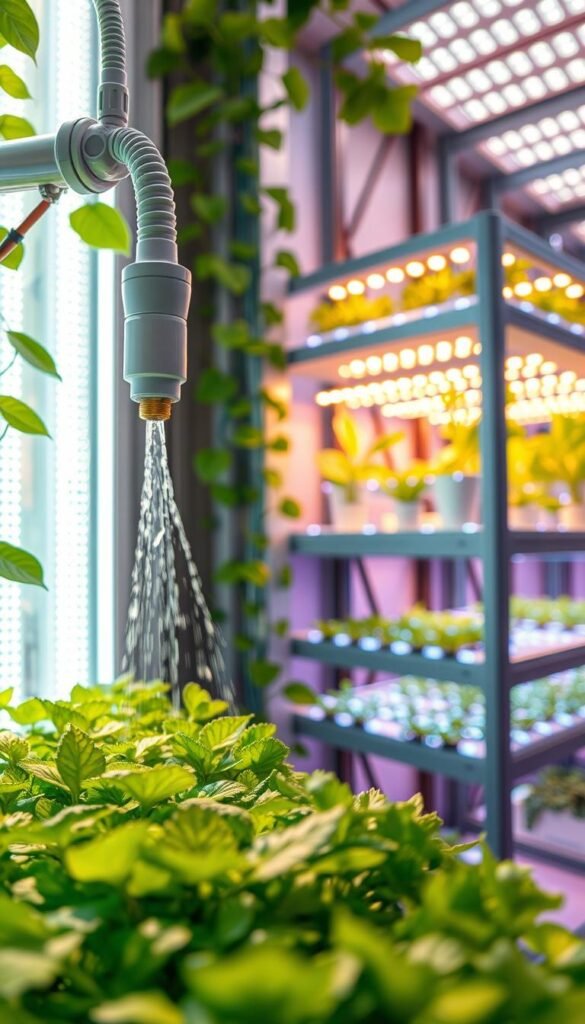
What if your garden could manage itself? Modern tech turns plant walls into intelligent ecosystems. Sensors and apps now handle watering schedules, light cycles, and nutrient delivery—letting you focus on enjoying fresh herbs instead of maintenance.
Automated Nutrient and Moisture Systems
Smart dosing systems act like personal chefs for your plants. They mix fertilizer blends tailored to each growth phase—seedlings get nitrogen boosts while fruiting plants receive extra potassium. No more burned leaves from guesswork!
IoT sensors track soil moisture 24/7. They send water only when roots need hydration, cutting waste by half. These systems prevent both drought stress and root rot, adapting to weather changes automatically.
| System Type | Key Features | Water Savings | Best For |
|---|---|---|---|
| Nutrient Dosing | Stage-based feeding | 30% | Edible plants |
| Moisture Sensors | Real-time tracking | 55% | All plant types |
| LED Grow Lights | Custom light recipes | N/A | Low-light areas |
Programmable LEDs boost growth with science-backed light recipes. Red wavelengths encourage flowering, while blue tones strengthen leaves. Sync them with apps like GrowLink to adjust schedules remotely.
Receive phone alerts when reservoirs need refills or temperatures drop. These set-and-forget options let urban growers harvest 25% more greens with less daily effort. Your green wall just got a tech upgrade!
Choosing the Best Plants for Vertical Success
Not all greenery thrives when stacked skyward—smart selections make the difference. Focus on species that adapt well to confined spaces and varying light conditions. Your choices will determine whether your setup becomes a thriving oasis or a wilted disappointment.
Herbs, Vegetables, and Edible Crops
Leafy greens like spinach and kale thrive upward thanks to shallow roots. Compact tomato varieties produce bumper crops in hanging planters—‘Tumbling Tom’ yields 100+ fruits per season. Basil and parsley grow vigorously in tight pockets, giving fresh flavors within arm’s reach.
Strawberries shine in vertical setups too. Their trailing habit suits tower planters, with fruits dangling like edible ornaments. These systems protect berries from ground pests while maximizing sun exposure.
Flowering, Climbing, and Succulent Varieties
Nasturtiums add pops of color while repelling aphids naturally. Train climbing roses or ivy up trellises for living privacy screens. Succulents like sedums handle dry conditions better than thirsty flowers—perfect for low-maintenance walls.
Mix textures for visual impact. Pair spiky aloe vera with soft creeping thyme. Remember: fast-growing climbers need sturdy supports, while slow growers suit delicate frameworks.

